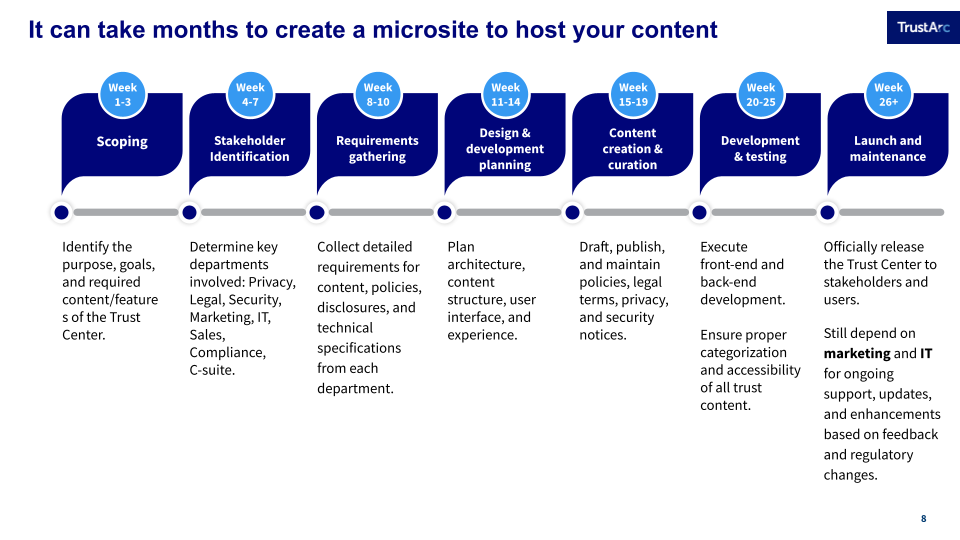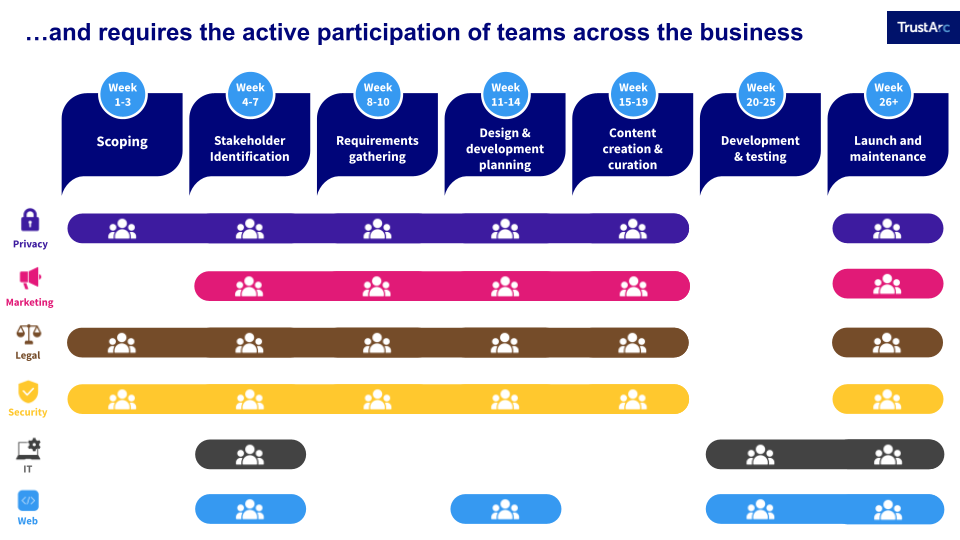From compliance to trust
As data breaches fill headlines and consumer skepticism is at an all-time high, the traditional view of privacy as merely a compliance requirement is rapidly becoming outdated. Privacy is growing. And it’s now a must-have for businesses.
Today, leading organizations understand that privacy is not just about meeting regulatory demands; it’s a strategic asset that can differentiate a brand and build deep, trusting customer relationships.
What caused this shift?
With the rise of technology and the internet over the past two decades, the amount of data available has exploded. Businesses recognized the potential to use this information to increase efficiency and profits.
And as technology use accelerated, regulators fell behind. In some companies, data protection and privacy fell by the wayside. But the enactment of the General Data Protection Regulation (GDPR) in 2018 ushered in a new era of privacy, where compliance was especially prioritized.
A positive privacy experience increases brand preference by as much as 43%.
Yet, in 2024, the tides have shifted again. Gone are the days when privacy was seen solely through the lens of regulation and compliance. Most of the population is protected under some type of data privacy regulation, and businesses have moved beyond privacy compliance to leveraging privacy as a differentiator.
For the second year in a row, TrustArc’s annual Global Privacy Benchmark survey reveals that ‘keeping brand trust’ was the top privacy goal for responding organizations. The report also highlights ‘risks to reputation and trust’ as the second highest privacy risk.
Consumers have also gotten savvier. Now, privacy is a pivotal point of customer experience, with a positive privacy experience increasing brand preference by as much as 43%. This dramatic shift signifies that customers are interested in the end product and the ethics and practices of the companies they engage with.
Companies like Apple are using this shift to their advantage. For example, Apple is known for championing user privacy. It encrypts all data stored on its devices and has a strict policy against collecting and sharing user data without explicit consent. And it focuses on educating consumers about how companies use their data and what options they have to protect it.
34% of consumers will switch companies after one suffers a data breach.
The standard has changed. B2B and B2C consumers expect businesses to be deeply committed to data protection and privacy. In fact, 34% of consumers will switch companies after one suffers a data breach.
The obscurity of trust and safety information
However businesses are running into a problem. Many companies’ policies, notices, communications, cookie banners, etc., aren’t building trust—they’re doing the opposite.
You can’t use privacy to build trust if your policies, notices, disclosures, overviews, and communications are scattered, outdated, and too hard to understand. From managing personalized data privacy preferences to real-time notifications about policy changes, customers want a better solution.
As technology advances and data becomes more valuable than ever, the importance of privacy and transparency will only grow. It’s no longer enough for organizations to simply comply with regulations and meet minimum requirements; they must prioritize building trust with their customers through transparency.
What is a unified Trust Center?
A Trust Center is more than a website or a section on a company’s page. It’s a comprehensive, centralized, virtual space where organizations transparently share privacy, legal, compliance, and security information. These centers demonstrate an organization’s commitment to safeguarding data and respecting user rights, showcasing everything from security reports such as SOC 2 and privacy certifications (e.g. TRUSTe Responsible AI Certification) to real-time updates on policy changes.
TrustArc’s Trust Center exemplifies this evolution, offering a seamless blend of brand elements that reinforce trust while managing all front-facing trust and safety information efficiently. By enabling organizations to update documents instantly and toggle between public and private settings, Trust Centers have become dynamic tools that reflect an organization’s live commitment to trust and safety.
It serves as a hub for consumer engagement, answering critical questions about a company’s privacy policies and practices. It has become a standard tool for managing trust content – crucial for organizations that uphold trust as a core brand value.
The ability to quickly provide stakeholders with easy access to privacy and security information streamlines workflows and drives tangible ROI through enhanced consumer relationships.
What is a Trust Center?
Understand the future of trust management for legal, security, compliance, and privacy professionals.
Read nowOn demand: Unified Trust Center
See how TrustArc Trust Center saves time and work while reducing legal and reputational risk.
Watch nowUnified Trust Center development
While building a unified Trust Center will vary depending on the organization, below is an example of what’s included in the process. For most organizations this takes at least three months and requires cross-collaboration between many stakeholders including privacy, security, legal, compliance, IT, marketing, and web development.
1. Strategic Planning and Vision:
Identify the trust center’s primary goals and determine its target audience and their specific needs. For example, simplify how the organization communicates and manages all trust and safety information, including privacy, security, legal, compliance, and product. The target audience includes consumers, regulators, and business partners or vendors. Establish a leadership team to oversee the project, align stakeholders, and assign roles and responsibilities.
2. Data Security and Privacy Notices and Policies:
Create or locate your data security and privacy notices and policies that adhere to applicable standards and regulations. Develop an internal audit of content and methods for easy maintenance of content updates.
3. Infrastructure and Technology:
Working with your organization’s information technology and security teams, establish a secure IT infrastructure with advanced security measures, secure data storage solutions, and backup mechanisms. Choose appropriate platforms for the Trust Center’s content management and website development.
4. Content Development:
Design a clear and intuitive information architecture for the Trust Center. Organize content into logical sections such as security, legal, privacy, and transparency/availability. Develop all necessary detailed documents including policies, procedures, certifications, and FAQs. Plan to update this content regularly to reflect the latest practices and updates.
5. Compliance and Certification:
If you haven’t already, consider obtaining relevant security and privacy certifications to display prominently on the Trust Center. Conduct regular audits and address their findings promptly and updated practices as needed.
6. User Experience and Design:
Design the Trust Center with a focus on usability and availability. Test the website’s responsiveness and be sure it works well on various devices and browsers. Incorporate interactive features like compliance reports, self-service portals, and customer support options. Provide tools for customers to assess your compliance and security posture and make individual rights requests.
Keep in mind that poor management of individual rights requests and a subpar user experience can undo the benefits of spending millions on building positive customer sentiment.
7. Continuous Improvement and Monitoring:
Implement tools to monitor the Trust Center’s performance, security, and user engagement. Use analytics to understand user behavior and improve the Trust Center continuously. Establish channels for user feedback and incorporate relevant suggestions into the Trust Center. Regularly review and iterate on your Trust Center based on user needs and industry trends.
8. Communication and Training:
Ensure all stakeholders know their roles in maintaining the Trust Center. Develop a communication plan to promote the trust center to customers and partners. Use various channels to keep stakeholders informed.
9. Incident Response and Management:
Have a clear process for reporting security incidents to customers. Provide timely updates and detailed reports on incidents and resolutions in the Trust Center.
10. Documentation and Reporting:
Gather detailed records of all security measures, compliance activities, and audit results. Be sure this information is easily accessible and current.


Aligning all stakeholders to plan and build a homegrown Trust Center is no easy task.
Not to mention, the build and continuous updates take away time from marketing and web development, costing between $15,000 and $30,000. It also takes weeks and months to build and maintain it (e.g., updating a policy or adding a downstream vendor).
There’s also an enhanced compliance risk to consider as legal and security teams will often need to wait several weeks for their updates to be implemented into the platform.
Don’t Create, Use Trust Center by TrustArc
The transition to viewing privacy as a trust-building tool represents an organizational cultural shift. TrustArc’s no-code Trust Center embodies this change, centralizing privacy, security, legal, and availability workflows, thereby enabling organizations to manage their front-facing trust efficiently.
As privacy regulations continue to evolve, so will the importance of trust and transparency in business practices. Organizations that strategically invest in building a strong Trust Center now will position themselves for long-term success as customer expectations shift towards increased privacy protection.
Creating a modern trust and safety hub like TrustArc’s unified Trust Center empowers core teams, setting up in minutes without the need for coding, and seamlessly blending brand elements into the Trust Center to reinforce trust. This approach enhances efficiency and showcases an organizational commitment to trust and safety by centralizing all relevant information.
The evolution of privacy from compliance to trust is an ongoing process, but embracing this shift can benefit businesses and consumers significantly.
By prioritizing transparency and investing in a comprehensive Trust Center, organizations can build strong customer relationships based on trust and ethical data practices. This will set them apart in a crowded marketplace and foster long-term loyalty and support, as privacy remains a crucial concern for individuals worldwide.
So, the message is clear- make sure your organization has a robust Trust Center in place to reduce reputational and legal risk, while achieving trust by demonstrating your commitment to privacy.
The Trust Center Advantage
A guide to efficient compliance and trust enhancement through innovative information sharing.
Download nowBuild trust with a Trust Center
Discover a purpose-built “no-code” online Trust Center that simplifies all aspects of public-facing trust and safety.
Start today



